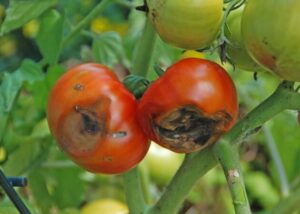GARDENING: Do you have tomato troubles?
You waited all season for that first red ripe tomato only to discover less-than-perfect fruit. Don’t worry, you can still have a great harvest and improve things for next season.
Blossom end rot is a common problem on the first set of fruit. The bottom of the tomato turns black. This is not caused by a disease but is the result of a calcium deficiency in the developing fruit. This deficiency is usually caused by fluctuations in water uptake by the plant. Fluctuating soil moisture, damage to the roots, excessive nitrogen fertilizer and high humidity can all impact water and calcium uptake and result in blossom end rot.
The first set of fruit are most susceptible because young tomato plants are growing rapidly and require more water and calcium. As the plants mature, the problem is less common.

Avoid the problem by watering thoroughly to encourage deep roots. Mulch the soil to help conserve moisture and suppress weeds. Avoid excessive fertilization and be mindful when weeding near the plants. And consider growing more blossom end rot resistant tomatoes like the All-America Selections winner Early Resilience.
READ: Food trends to look for in 2020
Don’t pitch blossom end rot tomatoes in the trash. Just cut off and compost the black portion and enjoy the rest.
Cracked fruit is another problem that worries gardeners. Fluctuating temperatures, moisture, high humidity and improper fertilization result in irregular development of the fruit and cracking.
These cracks often occur when heavy rains follow a dry spell. The rapid change in soil moisture causes the fruit to expand faster than the skin of the tomato. Vertical splits on the side of the tomato are called radial cracks. These are the most serious and commonly occur during hot and humid weather. Concentric cracking appears as rings of cracks around the stem of the fruit.
When cracks appear on green tomatoes the fruit usually rots before it ripens. Since this is not caused by a disease, the rotten fruit is safe to compost. Save affected fruit by harvesting cracked tomatoes immediately and finish ripening them inside. The flavor is not as good as tomatoes that ripened on the vine during sunny weather, but you’ll still be able to enjoy the harvest. If the tomatoes develop a sour smell or begin to ooze, toss them in the compost pile.
Catfacing is another disorder you may discover when harvesting your tomatoes. The blossom scar on the bottom of the fruit becomes enlarged or perforated. It is not clear what causes the problem, but it appears to be more common when cold temperatures occur during flowering, there are extreme fluctuations in day and night temperatures, excessive pruning has occurred or there’s been an overapplication of nitrogen fertilizer. As long as the fruit is otherwise undamaged, it is safe to eat.
When these problems occur make notes to correct your garden maintenance to avoid these problems in the future.
Melinda Myers is the author of more than 20 gardening books, including Small Space Gardening. She hosts The Great Courses “How to Grow Anything” DVD series and the nationally-syndicated Melinda’






